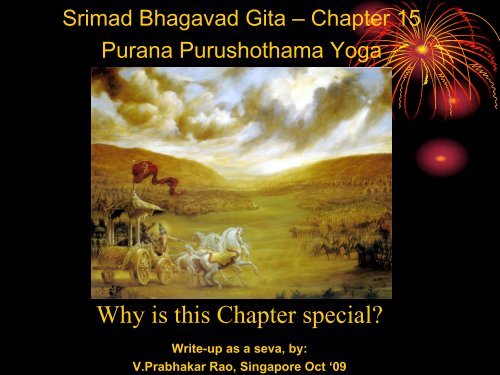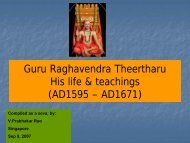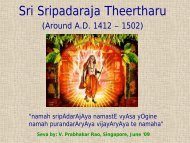Srimad Bhagavad Gita - Rayarusgrace.org
Srimad Bhagavad Gita - Rayarusgrace.org
Srimad Bhagavad Gita - Rayarusgrace.org
You also want an ePaper? Increase the reach of your titles
YUMPU automatically turns print PDFs into web optimized ePapers that Google loves.
<strong>Srimad</strong> <strong>Bhagavad</strong> <strong>Gita</strong> – Chapter 15<br />
Purana Purushothama Yoga<br />
Why is this Chapter special?<br />
Write-up as a seva, by:<br />
V.Prabhakar Rao, Singapore Oct ‘09
Dedication<br />
I am writing this on the sacred day of Sri Vijaya Dasaru Aradhana. My<br />
namaskara to my Guru Sri Raghavendra Guru Rayaru and to Sri Vijaya Dasaru,<br />
seeking their inspiration ….<br />
“Nimma Olimeyindha”
Overview of Chapter 15<br />
(A) Swarupa of the world: In the first two and a half slokas<br />
Lord explains the swarupa of the world.<br />
(B) Sadhanas to reach God: In the next two and a half slokas<br />
He talks about the ways (sadhanas) to reach Him.<br />
(C ) Bhagavath Swarupa: The next six slokas see Him<br />
describing the Bhagavath swarupa.<br />
(D) Hari as sarvantharyami: The following four slokas explain<br />
that Lord Hari is the sarvantharyami.<br />
(E) Hari Sarvothamatva: Finally, the the last five slokas of the<br />
chapter proclaim Lord as the Sarvothama.
Overview of Chapter 15<br />
It is said that:<br />
Mahabharatha is the most celebrated among the shasthras<br />
<strong>Bhagavad</strong> <strong>Gita</strong> is the most important part of Mahabharatha<br />
The 15 th chapter is the most important one in <strong>Bhagavad</strong> <strong>Gita</strong><br />
And the slokas 16 to 19 are the most important ones in this chapter<br />
It is said that <strong>Srimad</strong> Acharya has used these slokas in many of his works
Sriman Madhwa Siddhantha<br />
& Chapter 15<br />
The slokas 16 to 19 contain the gist of Sriman Madhwa Siddhantha:<br />
1. Hari Sarvothama - Sloka 18<br />
2. Sathyam Jagath - Sloka 17<br />
3. Pancha bedha - Slokas 16/17/18<br />
4. Jeevas as Haridasas - Sloka 17<br />
5. Tharathamya of jeevas - Sloka 16<br />
6. Mukthi of satvika jeeva - Sloka 20 (and slokas from<br />
ch 14)<br />
7. Bhakthi as Moksha sadhanam - Sloka 20<br />
8. Pramanas - Slokas 16/17/18<br />
9. Knowing Lord through Vedhas - Sloka 19
I. Swarupa of the world<br />
sri-bhagavan uvaca<br />
urdhva-mulam adhah-sakham ashvattham prahur avyayam<br />
chandamsi yasya parnani yas tam veda sa veda-vit (15:1)<br />
adhas cordhvam prasrtas tasya sakha guna-pravrddha visaya-pravalah<br />
adhas ca mulany anusantatani karmanubandhini manushya-loke (15:2)<br />
na rupam asyeha tathopalabhyate nanto na cadir na ca sampratishtha (15:3A)<br />
These two and a half slokas explain the swarupa of the world. World is like<br />
an Aswaththa tree, but with its roots on top and branches below. Sri Vishnu,<br />
Sri Lakshmi and Jadaprakrithi are the roots. Vedas are the leaves. This<br />
world is dynamic but eternal ……….<br />
This swarupa of the world is not understood and Sri Vishnu, who is the<br />
Creator, Sustainer & Destroyer of this world, is also not understood.
ashvattham enam su-virudha-mulam asanga-sastrena drdhena chittva<br />
(15:3B)<br />
tatah padam tat parimargitavyam yasmin gata na nivartanti bhuyah<br />
tam eva cadyam purusham prapadye yatah pravrttih prasrta purani (15:4)<br />
nirmana-moha jita-sanga-dosa adhyatma-nitya vinivrtta-kamah<br />
dvandvair vimuktah sukha-duhkha-samjnair gacchanty amudhah padam<br />
avyayam tat (15:5)<br />
II. Sadhanas to reach God<br />
These two and a half slokas talk about the sadhanas to reach God.<br />
With the help of the weapon called Gnana, strengthened with detachment, one<br />
should cut this tree, one should seek this Sri Vishnu and take refuge in Him.<br />
Those without ahankara and detached from vishayas …. ever involved in<br />
bhagavath vichara … away from desire … equally detached from pleasures &<br />
pains ….. such mukthi-yogyas reach the Lord.
na tad bhasayate suryo na sasanko na pavakah<br />
yad gatva na nivartante tad dhama paramam mama (15:6)<br />
mamaivamso jiva-loke jiva-bhutah sanatanah<br />
manah-sasthanindriyani prakriti-sthani karshati (15:7)<br />
sariram yad avapnoti yac capy utkramatishvarah<br />
grhitvaitani samyati vayur gandhan ivasayat (15:8)<br />
III. Bhagavath Swarupa<br />
The next 6 slokas (6 to 11) narrate the Swarupa<br />
of the Lord.<br />
Lord says that His is the exalted swarupa which<br />
when the Gnanis reach they never return to<br />
samsara. He says Sun, Moon and even Agni<br />
are not the ones who instill the brightness in His<br />
swarupa. ………………….<br />
Jeevas are binna amsa of Sri Vishnu and their<br />
indriyas are made active & dynamic only by Sri<br />
Vishnu. Hence to cut the worldly tree of<br />
samsara, one should take refuge at the lotus<br />
feet of Sri Vishnu.
III. Bhagavath Swarupa (contd)<br />
srotram caksuh sparshanam ca rasanam ghranam eva ca<br />
adhisthaya manas cayam visayan upasevate (15:9)<br />
utkramantam sthitam vapi bhunjanam va gunanvitam<br />
vimudha nanupasyanti pasyanti jnana-caksusah (15:10)<br />
yatanto yoginas cainam pasyanty atmany avasthitam<br />
yatanto ’py akritatmano nainam pasyanty acetasah (15:11)<br />
Bhagavan uses the indriyas of the jeevas<br />
and experiences the vishayas (sabdam,<br />
roopam, sparsham, rasam, vasana). Such<br />
a Bhagavan, who is residing in the jeevas,<br />
is seen by the Gnanis. Agnanis are unable<br />
to. Those who know the gnana upaya do<br />
take the efforts, earn the required gnana<br />
and thus see the Lord, who is inside.<br />
Those who do not have this buddhi, do<br />
not succeed even if they try.
IV. Sarvantaryamitva of Bhagavan<br />
yad aditya-gatam tejo jagad bhasayate ’khilam<br />
yac candramasi yac cagnau tat tejo viddhi mamakam (15:12)<br />
gam avisya ca bhutani dharayamy aham ojasa<br />
pusnami causadhih sarvah somo bhutva rasatmakah (15:13)<br />
aham vaisvanaro bhutva praninam deham asritah<br />
pranapana-samayuktah pacamy annam catur-vidham (15:14)<br />
sarvasya caham hridi sannivisto mattah smritir jnanam apohanam ca<br />
vedais ca sarvair aham eva vedyo vedanta-krd veda-vid eva caham (15:15)<br />
In these four slokas 12 to 15, Bhagavan explains that He is present everywhere<br />
in various rupas (sarvantaryami). Lord declares that the shakthi of Sun, Moon &<br />
Agni which brightens the world, actually is His. In the glorious sloka 13, Lord<br />
says that he gets inside the earth and supports everything and that He is the one<br />
who is inside the Moon and helps all plants to grow. Lord also declares that He is<br />
the one who is inside everyone as Vaisvanara and, along with Prana & Apana,<br />
digests the four types of food. Further, He states that He gets into everyone’s<br />
heart and from Him, memory, intellect and illusion are created. He categorically<br />
declares that He is the one to be seen through Vedas. He is the one who<br />
understands the true import of Vedas and has created the Vedantha.
V. Hari Sarvothamatva<br />
dvav imau purushau loke ksharas cakshara eva ca<br />
ksharah sarvani bhutani kuta-stho ’kshara ucyate (15:16)<br />
uttamah purushas tv anyah paramatmety udahrtah<br />
yo loka-trayam avisya bibharty avyaya ishvarah (15:17)<br />
As the grand finale of this chapter, in the slokas 16 to 20, Lord Krishna<br />
declares Himself as the Sarvothama. The Hari Sarvothamatva is anchored<br />
in these slokas. Let us look at this most important part a bit in detail.<br />
In sloka 16 Lord says that there are two types of chetanas. Those<br />
(Brahmadhi jeevas) whose chetanas get destroyed (kshara) and the one<br />
(Sri Lakshmi) whose chetana does not get destroyed (akshara). But the<br />
Uthama Purusha is above both these types of chetanas. He is the<br />
Easwara who enters the three lokas (bhooh, bhuvah, svah) and maintains<br />
them and is indestructible.
V. Hari Sarvothamatva<br />
yasmat ksharam atito ’ham aksharad api cottamah<br />
ato ’smi loke vede ca prathitah purushottamah (15:18)<br />
yo mam evam asammudho janati purushottamam<br />
sa sarva-vid bhajati mam sarva-bhavena bharata (15:19)<br />
“The One who is thus above Ksharas<br />
and Akshara and is glorified as<br />
“Purushothama” in the world and in<br />
Vedas, is none other than me (Lord<br />
Krishna)”<br />
And Lord Krishna further states that<br />
he who knows Him thus, as<br />
Purushothama, has understood the<br />
meaning of entire Veda shasthras and<br />
he will be worshipping Him with every<br />
type of Bhakthi.
iti guhyatamam shastram idam uktam mayanagha<br />
etad buddhva buddhiman syat krita-krtyas ca<br />
bharata (15:20)<br />
V. Hari Sarvothamatva<br />
“Thus this sasthra (that Vishnu is like the root of<br />
the tree that is samsara, that Vishnu is<br />
sarvantharyami and that Vishnu is Sarvothama) is<br />
to be learnt. It is a secretive knowledge taught by<br />
Me. He who learns it will become a gnani<br />
(aparoksha gnani) and one who has performed<br />
what should be performed (mukthan)” – Lord<br />
Krishna<br />
Om tat sat ithi srimad bhagavadgitasu upanishadsu brahma vidyayaam<br />
yogashasthrey srikrishnarjuna samvadhe puraana purushoththama yogonaama<br />
panchadasodhyaya:
Dwadasha Stotra 9-15 (Sri Madhwacharya)<br />
The 15 th sloka in the 9 th Dwadasha stotra is a brief summary of the entire 15 th chapter of<br />
<strong>Bhagavad</strong> <strong>Gita</strong>.<br />
“For the entire Jagat He is the creator. He is responsible for the destruction. He is the<br />
one responsible for bringing in the ananda in moksha. He surpasses both ksharas as<br />
well as aksharas and is unique”
Dwadasha Stotra 3-2 (Sri Madhwacharya)<br />
The 2 nd sloka in the 3 rd Dwadasha stotra reflects the essence of the entire 15 th chapter<br />
of <strong>Bhagavad</strong> <strong>Gita</strong>.<br />
“There is none other than Sri Hari who is Purushothama. Nowhere anyone is found<br />
equal to Him or above Him. There is no reason to have too much attachments in the<br />
worldly affairs. The devotee should constantly keep his mind on the lotus feet of Sri Hari”
The mahima of the final five slokas<br />
It is said that doing a<br />
parayana of the last five<br />
slokas is as effective as<br />
doing a parayana of the<br />
entire 15 th chapter. Such<br />
is the mahima of these<br />
slokas.
DHARMA BRINGS HAPPINESS<br />
Sri Krishnarpanamasthu
<strong>Srimad</strong> <strong>Bhagavad</strong> <strong>Gita</strong> – Chapter 15<br />
Purana Purushothama Yoga<br />
Acknowledgements with thanks:<br />
• “<strong>Srimad</strong> <strong>Bhagavad</strong> <strong>Gita</strong>” - a book by Sri Kumbakonam M.<br />
Ramarao based on Sri Raghavendra Guru Rayaru’s “<strong>Gita</strong>rtha<br />
sangraha”<br />
• “Heart of Bhagavat <strong>Gita</strong>” by Sri T.S.Raghavendran … a<br />
SMSO publication<br />
• Worldwide net





